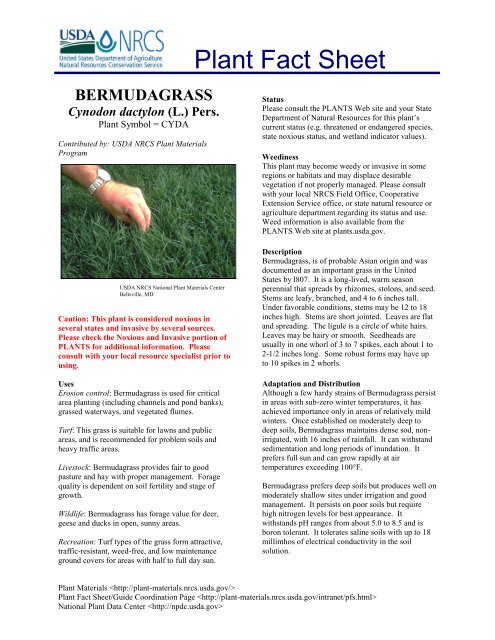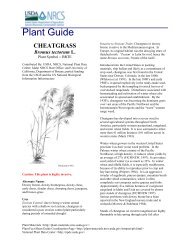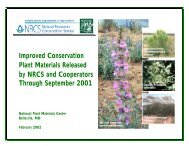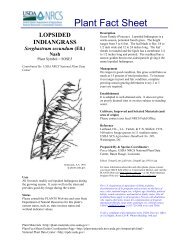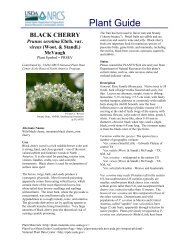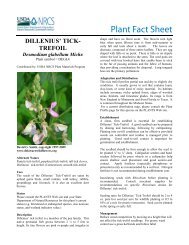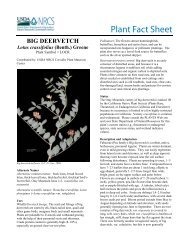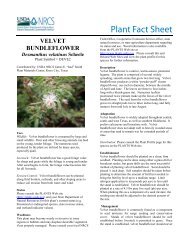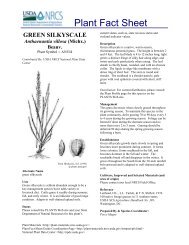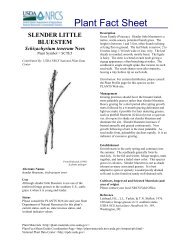pdf - Plant Fact Sheet - USDA Plants Database - US Department of ...
pdf - Plant Fact Sheet - USDA Plants Database - US Department of ...
pdf - Plant Fact Sheet - USDA Plants Database - US Department of ...
You also want an ePaper? Increase the reach of your titles
YUMPU automatically turns print PDFs into web optimized ePapers that Google loves.
BERMUDAGRASS<br />
Cynodon dactylon (L.) Pers.<br />
<strong>Plant</strong> Symbol = CYDA<br />
Contributed by: <strong><strong>US</strong>DA</strong> NRCS <strong>Plant</strong> Materials<br />
Program<br />
<strong><strong>US</strong>DA</strong> NRCS National <strong>Plant</strong> Materials Center<br />
Beltsville, MD<br />
Caution: This plant is considered noxious in<br />
several states and invasive by several sources.<br />
Please check the Noxious and Invasive portion <strong>of</strong><br />
PLANTS for additional information. Please<br />
consult with your local resource specialist prior to<br />
using.<br />
Uses<br />
Erosion control: Bermudagrass is used for critical<br />
area planting (including channels and pond banks),<br />
grassed waterways, and vegetated flumes.<br />
Turf: This grass is suitable for lawns and public<br />
areas, and is recommended for problem soils and<br />
heavy traffic areas.<br />
Livestock: Bermudagrass provides fair to good<br />
pasture and hay with proper management. Forage<br />
quality is dependent on soil fertility and stage <strong>of</strong><br />
growth.<br />
Wildlife: Bermudagrass has forage value for deer,<br />
geese and ducks in open, sunny areas.<br />
Recreation: Turf types <strong>of</strong> the grass form attractive,<br />
traffic-resistant, weed-free, and low maintenance<br />
ground covers for areas with half to full day sun.<br />
<strong>Plant</strong> <strong>Fact</strong> <strong>Sheet</strong><br />
Status<br />
Please consult the PLANTS Web site and your State<br />
<strong>Department</strong> <strong>of</strong> Natural Resources for this plant’s<br />
current status (e.g. threatened or endangered species,<br />
state noxious status, and wetland indicator values).<br />
Weediness<br />
This plant may become weedy or invasive in some<br />
regions or habitats and may displace desirable<br />
vegetation if not properly managed. Please consult<br />
with your local NRCS Field Office, Cooperative<br />
Extension Service <strong>of</strong>fice, or state natural resource or<br />
agriculture department regarding its status and use.<br />
Weed information is also available from the<br />
PLANTS Web site at plants.usda.gov.<br />
Description<br />
Bermudagrass, is <strong>of</strong> probable Asian origin and was<br />
documented as an important grass in the United<br />
States by l807. It is a long-lived, warm season<br />
perennial that spreads by rhizomes, stolons, and seed.<br />
Stems are leafy, branched, and 4 to 6 inches tall.<br />
Under favorable conditions, stems may be 12 to 18<br />
inches high. Stems are short jointed. Leaves are flat<br />
and spreading. The ligule is a circle <strong>of</strong> white hairs.<br />
Leaves may be hairy or smooth. Seedheads are<br />
usually in one whorl <strong>of</strong> 3 to 7 spikes, each about 1 to<br />
2-1/2 inches long. Some robust forms may have up<br />
to 10 spikes in 2 whorls.<br />
Adaptation and Distribution<br />
Although a few hardy strains <strong>of</strong> Bermudagrass persist<br />
in areas with sub-zero winter temperatures, it has<br />
achieved importance only in areas <strong>of</strong> relatively mild<br />
winters. Once established on moderately deep to<br />
deep soils, Bermudagrass maintains dense sod, nonirrigated,<br />
with 16 inches <strong>of</strong> rainfall. It can withstand<br />
sedimentation and long periods <strong>of</strong> inundation. It<br />
prefers full sun and can grow rapidly at air<br />
temperatures exceeding 100°F.<br />
Bermudagrass prefers deep soils but produces well on<br />
moderately shallow sites under irrigation and good<br />
management. It persists on poor soils but require<br />
high nitrogen levels for best appearance. It<br />
withstands pH ranges from about 5.0 to 8.5 and is<br />
boron tolerant. It tolerates saline soils with up to 18<br />
millimhos <strong>of</strong> electrical conductivity in the soil<br />
solution.<br />
<strong>Plant</strong> Materials <br />
<strong>Plant</strong> <strong>Fact</strong> <strong>Sheet</strong>/Guide Coordination Page <br />
National <strong>Plant</strong> Data Center
Bermudagrass is distributed throughout the majority<br />
<strong>of</strong> the United States. For a current distribution map,<br />
please consult the <strong>Plant</strong> Pr<strong>of</strong>ile page for this species<br />
on the PLANTS Website.<br />
Establishment<br />
Stands may be established by use <strong>of</strong> seed, sprigs, or<br />
plugs planted during mid-spring to mid-summer<br />
followed by frequent applications <strong>of</strong> fertilizer and<br />
water. Early planting is most important in areas <strong>of</strong><br />
marginal adaptability.<br />
Beds for seeding or planting should be firm, smooth,<br />
and free <strong>of</strong> weed seed. For turf plantings, absolute<br />
smoothness is necessary for close mowing following<br />
establishment. Seed, sprigs, or plugs should be<br />
placed into moist soil.<br />
For pasture or hay, drill 3 pounds pure live seed per<br />
acre at 1/2 inch depth or less. For turf, use 10 pounds<br />
<strong>of</strong> seed per acre. Higher seeding rates are advisable<br />
if seed must be broadcast. If using sprigs, broadcast<br />
by hand or with hydro-equipment. Punching and<br />
irrigation, if needed, must be done immediately<br />
following spreading to keep the sprigs from drying<br />
out. Surface soil moisture must be kept high while<br />
roots and shoots develop at the sprig nodes.<br />
Fifteen bushels <strong>of</strong> sprigs per acre disk punched or<br />
covered with 1-1/2 inches <strong>of</strong> soil followed by<br />
irrigation as needed ordinarily gives fully established<br />
stands in one growing season. On saline soils<br />
planting in the side <strong>of</strong> furrows is desirable so salts<br />
will accumulate on the ridges above grass rows.<br />
Use <strong>of</strong> sod rolls or plugs cut from sod is <strong>of</strong>ten a<br />
preferred method <strong>of</strong> establishing turf-type Bermuda<br />
on critical sites. Plugs <strong>of</strong> 3 inch diameter planted on<br />
15 to 18 inch centers will ordinarily establish<br />
complete cover in 1 growing season with adequate<br />
fertilizer, moisture and half-day to full sun.<br />
Complete sodding is preferred for very critical areas<br />
or where immediate foot traffic is contemplated.<br />
Care immediately following planting is less critical<br />
on plantings <strong>of</strong> sod or plugs than turf-type sprigs.<br />
Management<br />
High quality turf will require frequent very low<br />
mowing, fertilizer, and water for vigorous growth.<br />
Clippings must be removed. A sharp reel-type<br />
mower will avoid unsightly scalping. Good to fair<br />
quality turf can be maintained on short water and low<br />
fertilizer schedules, thereby reducing mowing<br />
frequency.<br />
Bermudagrass will persist as a weed-free ground<br />
cover on soils <strong>of</strong> moderate to high water-holding<br />
capacity. Where desirable and permissible, midwinter<br />
controlled burning can be used to reduce<br />
thatch. Most herbicides used at recommended rates<br />
with reasonable care can be used to control<br />
undesirable plants without destroying fully<br />
established Bermudagrass. Applications <strong>of</strong> nitrogen<br />
every 2 to 5 years will be needed to maintain<br />
vigorous stands on most sites.<br />
Both pasture and hay require good rainfall and heavy<br />
fertilizer application for high yield and quality.<br />
Thirty to forty pounds <strong>of</strong> nitrogen should be applied<br />
in split increments for each ton <strong>of</strong> anticipated dry<br />
forage yield. Highest yields are obtained on good<br />
soils in areas <strong>of</strong> high average annual temperature<br />
with ample water. Harvest or graze at 3 to 4 week<br />
intervals for best yields <strong>of</strong> total digestible nutrient<br />
and protein.<br />
Pests and Potential Problems<br />
Several white grubs are known to feed on the root<br />
system, however they are normally not a major pest.<br />
Cultivars, Improved, and Selected Materials (and<br />
area <strong>of</strong> origin)<br />
‘Santa Ana’, ‘Tifway’, ‘Tifgreen’, ‘Tifdwarf’,<br />
‘Tufcote’, ‘Brazos’, ‘Quickstand’, ‘Coastal’,<br />
‘Coastcross-1’, and ‘Midland’. All form dense, finetextured,<br />
weed-free sods and tolerate drought, close<br />
mowing and heavy traffic, even on problem soils.<br />
Seeds, springs, and sod are all commercially<br />
available.<br />
Control<br />
Please contact your local agricultural extension<br />
specialist or county weed specialist to learn what<br />
works best in your area and how to use it safely.<br />
Always read label and safety instructions for each<br />
control method. Trade names and control measures<br />
appear in this document only to provide specific<br />
information. <strong><strong>US</strong>DA</strong>, NRCS does not guarantee or<br />
warranty the products and control methods named,<br />
and other products may be equally effective.<br />
Prepared By & Species Coordinator:<br />
<strong><strong>US</strong>DA</strong> NRCS <strong>Plant</strong> Materials Program<br />
Edited: 10Aug2000 JLK; 05jun06 jsp<br />
For more information about this and other plants, please contact<br />
your local NRCS field <strong>of</strong>fice or Conservation District, and visit the<br />
PLANTS Web site or the <strong>Plant</strong> Materials<br />
Program Web site
The U.S. <strong>Department</strong> <strong>of</strong> Agriculture (<strong><strong>US</strong>DA</strong>) prohibits<br />
discrimination in all its programs and activities on the basis <strong>of</strong><br />
race, color, national origin, sex, religion, age, disability, political<br />
beliefs, sexual orientation, and marital or family status. (Not all<br />
prohibited bases apply to all programs.) Persons with disabilities<br />
who require alternative means for communication <strong>of</strong> program<br />
information (Braille, large print, audiotape, etc.) should contact<br />
<strong><strong>US</strong>DA</strong>'s TARGET Center at 202-720-2600 (voice and TDD).<br />
To file a complaint <strong>of</strong> discrimination write <strong><strong>US</strong>DA</strong>, Director, Office<br />
<strong>of</strong> Civil Rights, Room 326-W, Whitten Building, 14th and<br />
Independence Avenue, SW, Washington, DC 20250-9410 or call<br />
202-720-5964 (voice or TDD). <strong><strong>US</strong>DA</strong> is an equal opportunity<br />
provider and employer.<br />
Read about Civil Rights at the Natural Resources Convervation<br />
Service.


